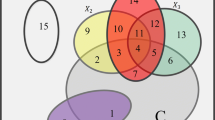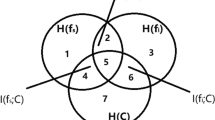Abstract
There are many feature selection algorithms based on mutual information and three-dimensional mutual information (TDMI) among features and the class label, since these algorithms do not consider TDMI among features, feature selection performance can be influenced. In view of the problem, this paper investigates feature selection based on TDMI among features. According to the maximal relevance minimal redundancy criterion, joint mutual information among the class label and feature set is adopted to describe relevance, and mutual information between feature set is exploited to describe redundancy. Then, joint mutual information among the class label and feature set as well as mutual information between feature set is decomposed. In the process of decomposing, TDMI among features is considered and an objective function is obtained. Finally, a feature selection algorithm based on conditional mutual information for maximal relevance minimal redundancy (CMI-MRMR) is proposed. To validate the performance, we compare CMI-MRMR with several feature selection algorithms. Experimental results show that CMI-MRMR can achieve better feature selection performance.



Similar content being viewed by others
References
Guyon I, Elisseeff A (2003) An introduction to variable and feature selection. J Mach Learn Res 3:1157–1182
Brown G, Pocock A, Zhao MJ, Lujan M (2012) Conditional likelihood maximisation: a unifying framework for information theoretic feature selection. J Mach Learn Res 13:27–66
Bolon CV, Sanchez MN, Alonso BA (2015) Recent advances and emerging challenges of feature selection in the context of big data. Knowl.-Based Syst 86:33–45
Huang XJ, Zhang L, Wang BJ, Li FZ, Zhang Z (2018) Feature clustering based support vector machine recursive feature elimination for gene selection. Appl Intell 48(3):594–607
Wang YW, Feng LZ, Zhu JM (2018) Novel artificial bee colony based feature selection method for filtering redundant information. Appl Intell 48(4):868–885
Shang CX, Li M, Feng SZ, Jiang QS, Fan JP (2013) Feature selection via maximizing global information gain for text classification. Knowl-Based Syst 54:298–309
Tang B, Kay S, He HB (2016) Toward optimal feature selection in naive bayes for text categorization. IEEE Trans Knowl Data Eng 28(9):2508–2521
Gu XY, Guo JC (2019) A study on Subtractive Pixel Adjacency Matrix features. Multimed Tools Appl 78(14):19681–19695
Gu XY, Guo JC, Wei HW, He YH (2020) Spatial-domain steganalytic feature selection based on three-way interaction information and KS test. Soft Comput 24(1):333–340
Fei T, Kraus D, Zoubir AM (2015) Contributions to Automatic Target Recognition Systems for Underwater Mine Classification. IEEE Trans Geosci Remote Sens 53(1):505–518
Zhang F, Chan PPK, Biggio B, Yeung DS, Roli F (2016) Adversarial feature selection against evasion attacks. IEEE Trans Cybern 46(3):766–777
Veronica BC, Noelia SM, Amparo AB (2013) A review of feature selection methods on synthetic data. Knowl Inf Syst 34(3):483–519
Jia XP, Kuo BC, Crawford MM (2013) Feature Mining for Hyperspectral Image Classification. Proc IEEE 101(3):676–697
Lin CH, Chen HY, Wu YS (2014) Study of image retrieval and classification based on adaptive features using genetic algorithm feature selection. Expert Syst Appl 41(15):6611–6621
Naghibi T, Hoffmann S, Pfister B (2015) A Semidefinite Programming Based Search Strategy for Feature Selection with Mutual Information Measure. IEEE Trans Pattern Anal Mach Intell 37(8):1529–1541
Estevez PA, Tesmer M, Perez CA, Zurada JA (2009) Normalized Mutual Information Feature Selection. IEEE Trans Neural Netw 20(2):189–201
Lewis DD (1992) Feature selection and feature extraction for text categorization. In: Proceedings of the workshop on speech and natural language, pp 212–217
Peng HC, Long FH, Ding C (2005) Feature selection based on mutual information: Criteria of max-dependency, max-relevance and min-redundancy. IEEE Trans Pattern Anal Mach Intell 27(8):1226–1238
Foithong S, Pinngern O, Attachoo B (2012) Feature subset selection wrapper based on mutual information and rough sets. Expert Syst Appl 39(1):574–584
Wang ZC, Li MQ, Li JZ (2015) A multi-objective evolutionary algorithm for feature selection based on mutual information with a new redundancy measure. Inform Sci 307:73–88
Zeng ZL, Zhang HJ, Zhang R, Yin CX (2015) A novel feature selection method considering feature interaction. Pattern Recogn 48(8):2656–2666
Bennasar M, Hicks Y, Setchi R (2015) Feature selection using Joint Mutual Information Maximisation. Expert Syst Appl 42(22):8520–8532
Wang J, Wei JM, Yang ZL, Wang SQ (2017) Feature Selection by Maximizing Independent Classification Information. IEEE Trans Knowl Data Eng 29(4):828–841
Jakulin A, Bratko I (2004) Testing the significance of attribute interactions. In: Proceedings of international conference on machine learning, pp 409–416
Battiti R (1994) Using mutual information for selecting features in supervised neural net learning. IEEE Trans Neural Netw 5(4):537–550
Kwak N, Choi CH (2002) Input feature selection for classification problems. IEEE Trans Neural Netw 13(1):143–159
Gu XY, Guo JC, Xiao LJ, Ming T, Li CY (2020) A Feature Selection Algorithm Based on Equal Interval Division and Minimal-Redundancy-Maximal-Relevance. Neural Process Lett 51(2):1237–1263
Sun X, Liu YH, Xu MT, Chen HL, Han JW, Wang KH (2013) Feature selection using dynamic weights for classification. Knowl.-Based Syst 37:541–549
Fleuret F (2004) Fast binary feature selection with conditional mutual information. J Mach Learn Res 5:1531–1555
Yang HH, Moody JE (1999) Data visualization and feature selection: new algorithms for nongaussian data. In: Proceedings of conference on neural information processing systems
Ren JF, Jiang XD, Yuan JS (2015) Learning LBP structure by maximizing the conditional mutual information. Pattern Recogn 48(10):3180–3190
Lin DH, Tang X (2006) Conditional infomax learning: An integrated framework for feature extraction and fusion. In: Proceedings of european conference on computer vision. pp 68–82
Gao WF, Hu L, Zhang P, He JL (2018) Feature selection considering the composition of feature relevancy. Pattern Recogn Lett 112:70–74
Gao WF, Hu L, Zhang P (2018) Class-specific mutual information variation for feature selection. Pattern Recogn 79:328–339
Dua D, Graff C (2019) UCI machine learning repository. University of California, Irvine, School of Information and Computer Sciences
Li JD, Cheng KW, Wang SH, Morstatter F, Trevino RP, Tang JL, Liu H (2018) Feature selection: a data perspective. ACM Comput Surv 50(6)
Fayyad UM, Irani KB (1993) Multi-interval discretization of continuous-valued attributes for classification learning. In: Proceedings of International Joint Conference on Artificial Intelligence. pp 1022–1027
Hall M, Frank E, Holmes G, Pfahringer B, Reutemann P, Witten IH (2009) The WEKA data mining software: an update. ACM SIGKDD Explor Newslett 11(1):10–18
Zhao Z, Morstatter F, Sharma S, Alelyani S, Anand A, Liu H (2010) Advancing feature selection research. ASU feature selection repository 1–28
Acknowledgements
This work was supported by the National Natural Science Foundation of China (61771334).
Author information
Authors and Affiliations
Corresponding author
Additional information
Publisher’s note
Springer Nature remains neutral with regard to jurisdictional claims in published maps and institutional affiliations.
Rights and permissions
About this article
Cite this article
Gu, X., Guo, J., Xiao, L. et al. Conditional mutual information-based feature selection algorithm for maximal relevance minimal redundancy. Appl Intell 52, 1436–1447 (2022). https://doi.org/10.1007/s10489-021-02412-4
Accepted:
Published:
Issue Date:
DOI: https://doi.org/10.1007/s10489-021-02412-4




